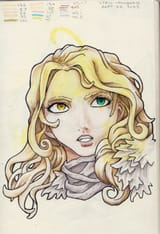>>7604580Draw some simple lines with a fineliner. Try using marker to color against one side of the line. You'll find it's easiest to judge the position of the very end of the marker tip, so generally, keep the marker pointed towards the line you're trying to follow.
Different markers will bleed differently on different papers, so don't color right up against an edge until you have some idea of the bleed distance.
Markers appearance varies with paper, and can be very different from caps or swatches. I always test at the edge of my page before using them.
Alcohol makers do smooth fills (no obvious dark overlaps between strokes) very well if you don't allow the previous stroke to "dry" before continuing.
Alcohol markers are great underlays for colored pencil. You can texture or vary a surface with the pencil without having to carefully fill the region with it-- the marker has already done so.
Some brands, some colors, will bleed. They'll bleed into the previous AND next pages in your sketchbook. They'll bleed onto the white backing of your scanner. And they can bleed for days and days, not just while you're working. So don't leave drawings in your scanner, and fold some scrap around your work in your sketchbook.
Pic related-- The yellow mess soaked through from an orange region on the prior page (not the facing page) long after both works were completed.
Seriously, this can be very color specific. You may feel safe having used a set often, and then encounter the one color that soaks into multiple finished pieces.
Finally, marker caps can be a bit stiff, and some markers will throw droplets of color when they finally come free. Turn away from your work when removing caps.
The above has been my experience, though I'm far from expert.
In the sketchbooks I use, the markers appear quite a bit darker than you might expect. So I always err on the lighter side when making color choices.

